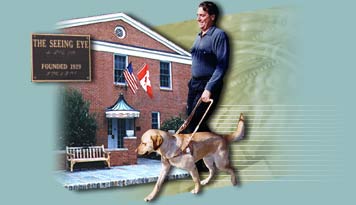 |
The Seeing Eye program
|
Types of Training
HISTORY OF THE FIRST ASSISTANCE DOG IN THE U.S.
The use of Assistance Animals in the United States actually began after World War I (1914-1918).
Dorothy Harrison Eustis, a wealthy American who was living in Switzerland saw blind German veterans being guided by trained German Shepherd Dogs during and after World War I. She was so impressed with what the dogs were able to do that she wrote an article for the Saturday Evening Post offering to work with one interested blind American at her kennels in Switzerland.
Out of hundreds of responses, she choose a 19-year-old boy named Morris Frank because of his intense desire for independence and his drive to help establish a guide dog training program in the United States.
The young man traveled to Switzerland to train with Eustis where he teamed up with a female German Shepherd named Buddy. After completing his training, he and Buddy came back to the U.S., where he publicized the advantages of working with a guide dog.
Despite resistance for developing a guide dog training program in the United States from several well-known organizations that worked with blind people, Frank and Eustis were able to raise public support to found The Seeing Eye guide dog organization in 1929. Over a period of time, they determined that the breeds that would work best for them were the German Shepherds, Golden Retrievers, and the ever popular Labrador Retrievers. To make sure that they were able to have a large pool of suitable dogs with the exact requirements for the job of guiding, they pioneered a breeding program to have a constant supply of canines where they would have the pick of the litters.
BACK TO TOP
 |
Maj helping to pick up a dropped item
|
HISTORY OF THE FIRST SERVICE DOGS IN THE U.S.
While Seeing Eye/Guide dogs have been in the U.S. for over 75 years, the other types of Assistance Dog programs have only been in existence since the early 70s.
Bonita Bergin pioneered the Service Dog movement that deals with mobility issues.
She had observed donkeys and other animals in several underdeveloped areas assisting people with physical disabilities, and came up with the idea of dogs working with mobility impaired individuals.
She sought advice from guide dog training programs but unfortunately they weren't responsive and offered her little help. She persevered though, and was finally able to develop the first Service Dog training program in the U.S., Canine Companions for Independence.
Increased awareness over the years of the value of Service Dogs helping mobility impaired people has caused the demand for trained Service Dogs to explode and many new training programs have been established to meet the need.
 |
|
|
Due to the varied needs required of a Service Dog, a large number of different breeds can be seen assisting people with physical disabilities and unlike guide dogs, they can come from Humane Societies, Rescue Organizations, special breeding programs or even already be the disabled person's pet.
BACK TO TOP
ASSISTANCE ANIMALS AND HOW THEY SERVE
While most people think the only Assistance Animals are Seeing Eye/Guide dogs, that is only a perception time has ingrained into the public. The vision assistance animals are only a small portion of the overall Assistance Animal population. Within the dog category, some examples of other types of Assistance Dogs are Seizure Alert dogs, Migraine Alert dogs, Autism dogs, Alzheimer's dogs, Post Traumatic Stress dogs, Hearing dogs, Cardio/Pulmonary/Vascular dogs, Psychiatric Aid dogs, as well as Mobility dogs. Many of these dogs aid a partner that does not show an obvious disability to the average person. Seizure Alert dogs are an excellent example since many of their partners appear totally *not*disabled for much of the time. But when their partner begins to have a seizure, these dogs are absolutely invaluable!
Below are brief descriptions of the more prevalent types of Assistance Animals that the public might see.
Assistance/Service Dogs are trained to perform physical tasks for people with mobility disabilities. Such tasks might include pulling wheelchairs, retrieving objects, opening doors and drawers and flipping switches for lights or automatic doors.
Hearing Dogs assist people who are deaf and hard of hearing by alerting them to a variety of household sounds: a knock on the door or a doorbell, a buzzing alarm clock, a ringing telephone, a baby's cry, a name being called or a smoke alarm going off. These dogs are trained to make physical contact, or at least get their partners' attention, and lead then to the source of the sound.
Seizure Dogs, sometimes referred to as 'seizure response dogs' or 'seizure alert dogs' are a relatively new concept, compared to other types of assistance dogs. These dogs are trained to assist people with epilepsy or other seizure disorders. They may either alert individuals to on-coming seizures, or react once seizures begin. This may either allow the individual to get to a safe place before a seizure begins, or provide the owner with direct physical contact until assistance arrives.
Dogs though, are not the only species of Assistance Animal used. There are a multitude of other animals trained to assist their disabled partners including, monkeys, miniature horses, cats, pigs, and even birds. While some of these animals only perform their Assistance Animal tasks in the home, they are still working animals that aid their human partners to have greater safety, independence, and dignity in their lives.
|